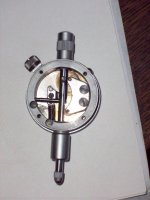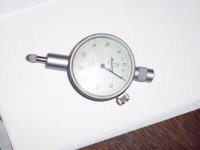I just got a Mitutoyo 1507 indicator with a bunch of parts. It looks like it was dropped, as the crystal had popped out and the shaft binds (the needle does not return to zero all the time). I took the back off and did not see any issues (and it was clean inside). I did see a you tube video on a Chinese made indicator where it had been dropped....and they took the bezel and faceplate off.....and there was adjustment screws under the faceplate. Once these were loosened and then adjusted, the binding went away
I'm assuming the Mitutoyo has something similar. However, it looks like the needle first needs to come off.
Does anyone know if there is a adjustment under the faceplate? If yes, what is the sequence to get the adjustment screws
thanks
dean
I'm assuming the Mitutoyo has something similar. However, it looks like the needle first needs to come off.
Does anyone know if there is a adjustment under the faceplate? If yes, what is the sequence to get the adjustment screws
thanks
dean




